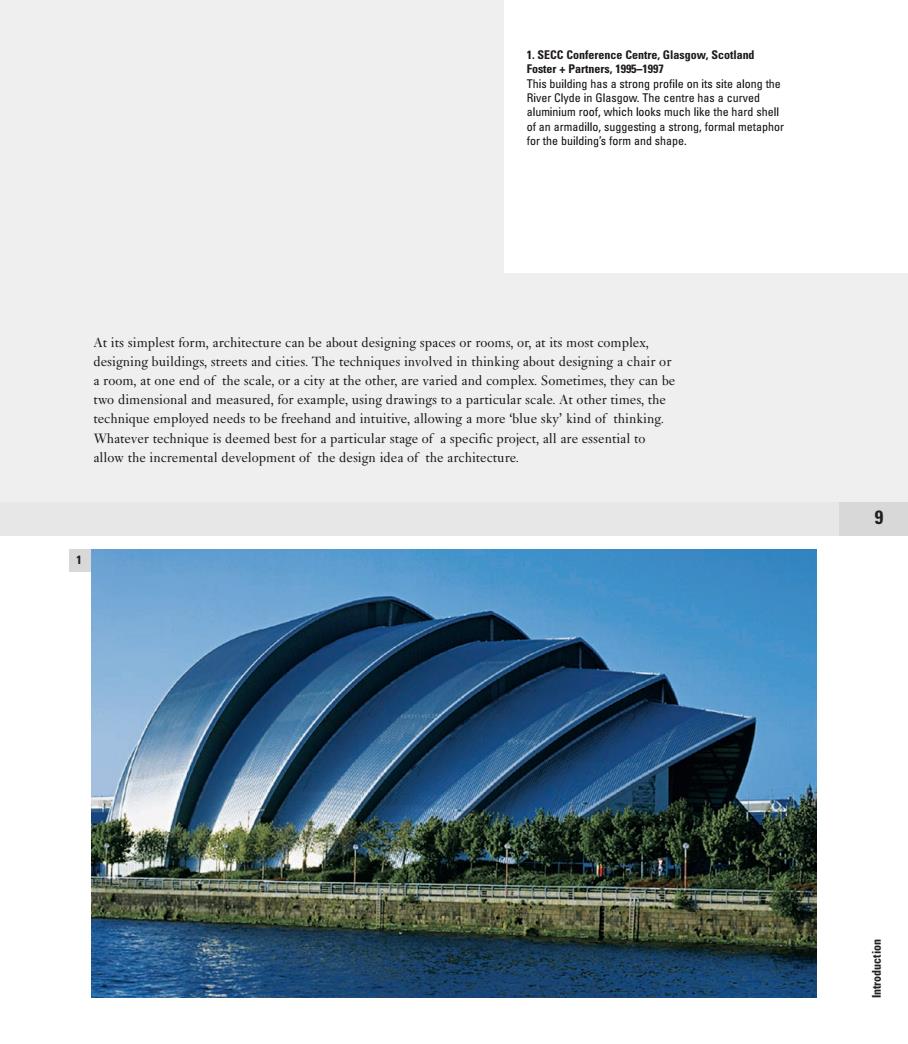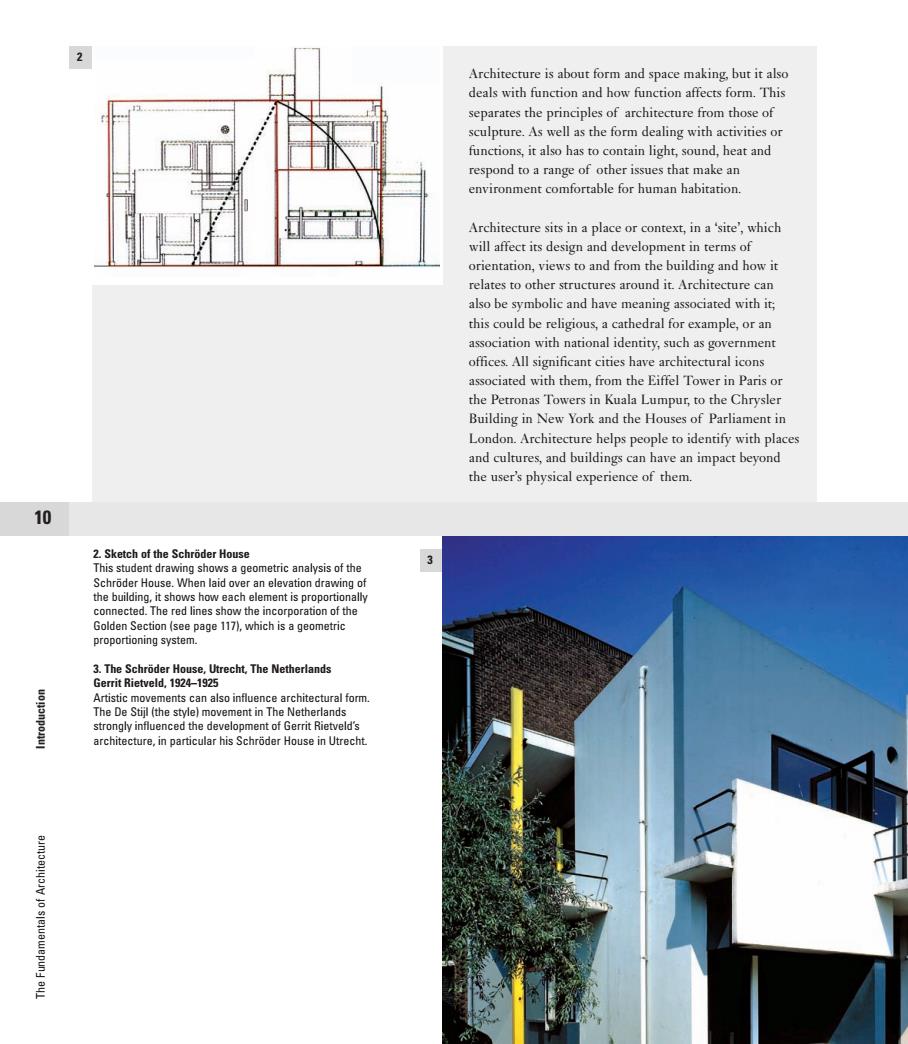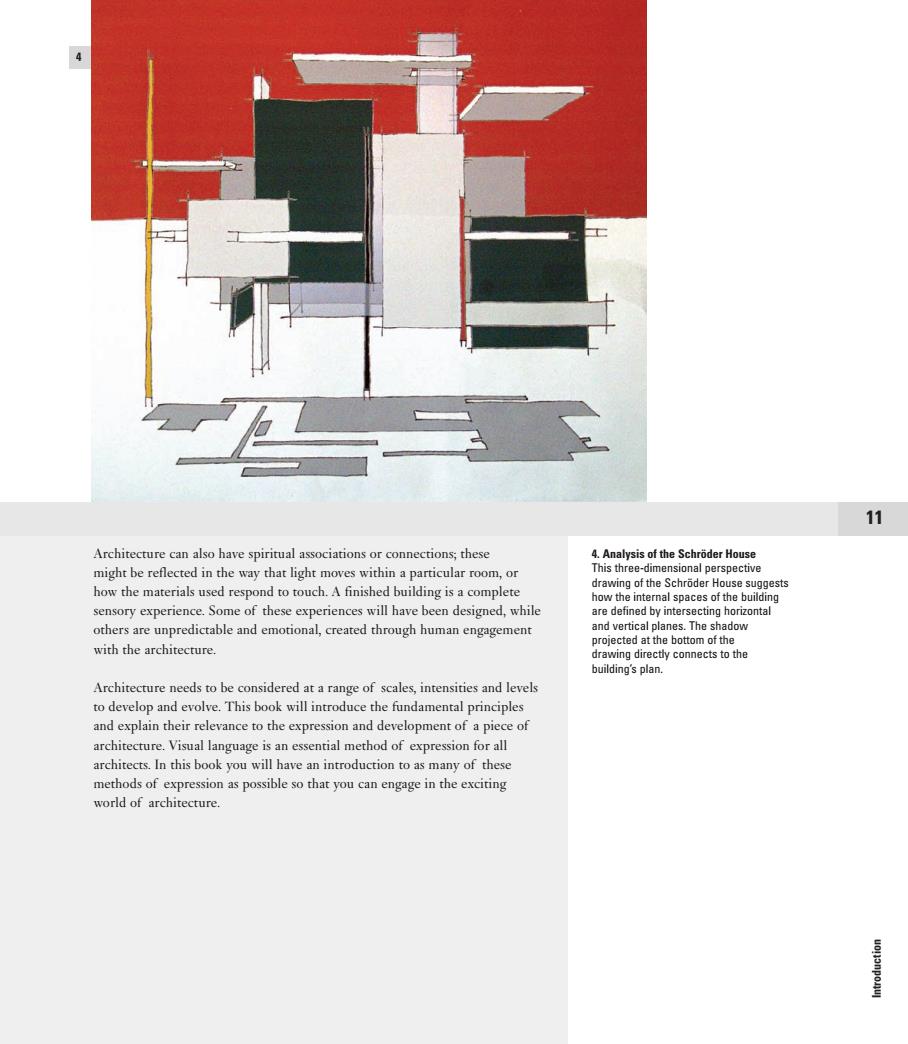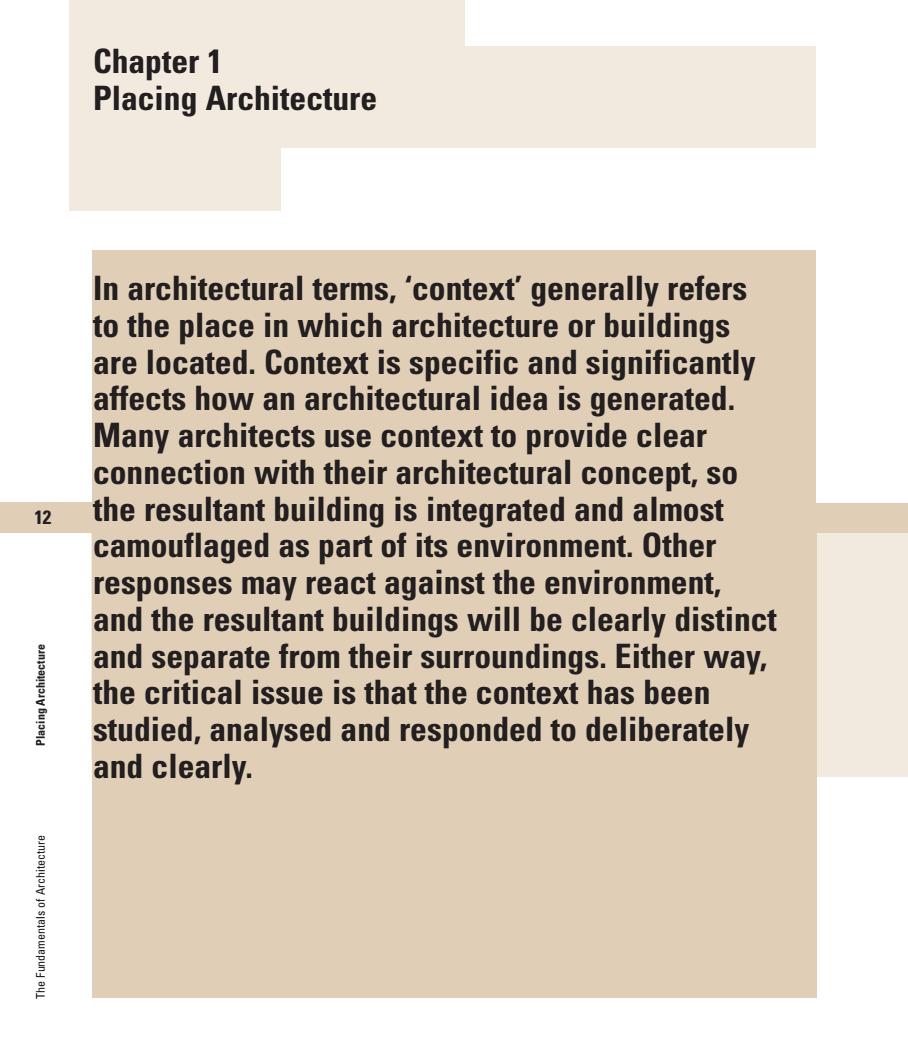
Introduction Architecture 1.The art or practice of designing and constructing buildings. 2.The style in which a building is designed and constructed. 8 Describing architecture as 'fundamental'might suggest requires an understanding of the context of buildings that there is a simplicity that underlies its expression. (which can be a landscape or the city,or somewhere in Architecture is a language that we understand because we between),and an understanding of the building itself,in inhabit buildings,they surround us and create our world. terms of its underlying concept or idea,its functions or To achieve a piece of architecture requires engaging with uses and its materiality and structure.This overview, a process of thinking,drawing and designing,a process however,exists at many levels and the next stage of that ultimately produces a building. understanding of building is as a series of rooms, connected spaces that lead from the outside in.Further This process begins with an idea or'concept'that relates consideration is the control of light and sound in those to a particular site or context.It further develops(through rooms and the furniture that inhabits the spaces.The a 'brief')into a 'form',which will have functions or architect is a designer whose remit ranges from the large activities associated with it.This form is then further scale of designing a city to the smaller scale of developed structurally (as a frame or system),and designing a chair. materially (with a 'skin'or 'wrapping).It is finally realised, framing experiences of light,sound,space. Architecture,as many other design disciplines,starts with concepts or ideas that initiate the creative process of The etymology of the word'architecture'can be defined thinking.These concepts can come from other(past or as arkbi meaning chief and tektou meaning builder or present)forms of architecture or architects,or from carpenter.This definition demonstrates the fundamental metaphors or analogies.These analogies can be to form: basis of architecture.As chief builder an architect the structure of the Scottish Exhibition and Conference uawepun needs to have an overview of building,both as an object Centre in Glasgow for example,has a shape and skin produced and as an activity of construction.This overview which resembles that of an armadillo
QC Preflight Point 2nd 11 11 p8 Job no : 76451 Title : The Fundamentals of Architecture Client : AVA Scn : #175 Size : 200(w)230(h)mm Co : M11 C0 (All To Spot)(Coagl)__LC Dept : DTP D/O : 07.05.07 (Job no:76451C1 D/O : 25.05.07 Co: CM11) 76451_CTP_001-051.qxd 5/23/07 9:05 AM Page 8 2nd p8 (Job no:76451C1 D/O : 25.05.07 Co: CM11) 8Introduction The Fundamentals of Architecture Describing architecture as ‘fundamental’ might suggest that there is a simplicity that underlies its expression. Architecture is a language that we understand because we inhabit buildings, they surround us and create our world. To achieve a piece of architecture requires engaging with a process of thinking, drawing and designing, a process that ultimately produces a building. This process begins with an idea or ‘concept’ that relates to a particular site or context. It further develops (through a ‘brief ’) into a ‘form’, which will have functions or activities associated with it. This form is then further developed structurally (as a frame or system), and materially (with a ‘skin’ or ‘wrapping’). It is finally realised, framing experiences of light, sound, space. The etymology of the word ‘architecture’ can be defined as arkhi meaning chief and tekton meaning builder or carpenter. This definition demonstrates the fundamental basis of architecture. As chief builder an architect needs to have an overview of building, both as an object produced and as an activity of construction. This overview requires an understanding of the context of buildings (which can be a landscape or the city, or somewhere in between), and an understanding of the building itself, in terms of its underlying concept or idea, its functions or uses and its materiality and structure. This overview, however, exists at many levels and the next stage of understanding of building is as a series of rooms, connected spaces that lead from the outside in. Further consideration is the control of light and sound in those rooms and the furniture that inhabits the spaces. The architect is a designer whose remit ranges from the large scale of designing a city to the smaller scale of designing a chair. Architecture, as many other design disciplines, starts with concepts or ideas that initiate the creative process of thinking. These concepts can come from other (past or present) forms of architecture or architects, or from metaphors or analogies. These analogies can be to form: the structure of the Scottish Exhibition and Conference Centre in Glasgow for example, has a shape and skin which resembles that of an armadillo. Architecture 1. The art or practice of designing and constructing buildings. 2. The style in which a building is designed and constructed. Introduction 76451_CTP_001-051.qxd 5/23/07 9:05 AM Page 8

1.SECC Conference Centre,Glasgow,Scotland Foster Partners,1995-1997 This building has a strong profile on its site along the River Clyde in Glasgow.The centre has a curved aluminium roof,which looks much like the hard shell of an armadillo,suggesting a strong,formal metaphor for the building's form and shape. At its simplest form,architecture can be about designing spaces or rooms,or,at its most complex, designing buildings,streets and cities.The techniques involved in thinking about designing a chair or a room,at one end of the scale,or a city at the other,are varied and complex.Sometimes,they can be two dimensional and measured,for example,using drawings to a particular scale.At other times,the technique employed needs to be freehand and intuitive,allowing a more blue sky'kind of thinking. Whatever technique is deemed best for a particular stage of a specific project,all are essential to allow the incremental development of the design idea of the architecture. 9 1
p9 QC Preflight Point 2nd 11 11 Job no : 76451 Title : The Fundamentals of Architecture Client : AVA Scn : #175 Size : 200(w)230(h)mm Co : M11 C0 (All To Spot)(Coagl)__LC Dept : DTP D/O : 07.05.07 (Job no: 76451C1 D/O : 25.05.07 Co: CM3) 76451_CTP_001-051.qxd 5/23/07 4:33 AM Page 9 p9 2nd 9Introduction At its simplest form, architecture can be about designing spaces or rooms, or, at its most complex, designing buildings, streets and cities. The techniques involved in thinking about designing a chair or a room, at one end of the scale, or a city at the other, are varied and complex. Sometimes, they can be two dimensional and measured, for example, using drawings to a particular scale. At other times, the technique employed needs to be freehand and intuitive, allowing a more ‘blue sky’ kind of thinking. Whatever technique is deemed best for a particular stage of a specific project, all are essential to allow the incremental development of the design idea of the architecture. 1 1. SECC Conference Centre, Glasgow, Scotland Foster + Partners, 1995–1997 This building has a strong profile on its site along the River Clyde in Glasgow. The centre has a curved aluminium roof, which looks much like the hard shell of an armadillo, suggesting a strong, formal metaphor for the building’s form and shape. 76451_CTP_001-051.qxd 5/23/07 4:33 AM Page 9

Architecture is about form and space making,but it also deals with function and how function affects form.This separates the principles of architecture from those of sculpture.As well as the form dealing with activities or functions,it also has to contain light,sound,heat and respond to a range of other issues that make an environment comfortable for human habitation. Architecture sits in a place or context,in a'site',which will affect its design and development in terms of orientation,views to and from the building and how it relates to other structures around it.Architecture can also be symbolic and have meaning associated with it; this could be religious,a cathedral for example,or an association with national identity,such as government offices.All significant cities have architectural icons associated with them,from the Eiffel Tower in Paris or the Petronas Towers in Kuala Lumpur,to the Chrysler Building in New York and the Houses of Parliament in London.Architecture helps people to identify with places and cultures,and buildings can have an impact beyond the user's physical experience of them. 10 2.Sketch of the Schroder House 3 This student drawing shows a geometric analysis of the Schroder House.When laid over an elevation drawing of the building,it shows how each element is proportionally connected.The red lines show the incorporation of the Golden Section (see page 117),which is a geometric proportioning system. 3.The Schroder House,Utrecht,The Netherlands Gerrit Rietveld,1924-1925 Artistic movements can also influence architectural form. The De Stijl(the style)movement in The Netherlands strongly influenced the development of Gerrit Rietveld's architecture,in particular his Schroder House in Utrecht
p10 QC Preflight Point 2nd 11 11 Job no : 76451 Title : The Fundamentals of Architecture Client : AVA Scn : #175 Size : 200(w)230(h)mm Co : M11 C0 (All To Spot)(Coagl)__LC Dept : DTP D/O : 07.05.07 (Job no:76451C1 D/O : 25.05.07 Co: CM11) 76451_CTP_001-051.qxd 5/23/07 9:07 AM Page 10 p10 3 10Introduction The Fundamentals of Architecture Architecture is about form and space making, but it also deals with function and how function affects form. This separates the principles of architecture from those of sculpture. As well as the form dealing with activities or functions, it also has to contain light, sound, heat and respond to a range of other issues that make an environment comfortable for human habitation. Architecture sits in a place or context, in a ‘site’, which will affect its design and development in terms of orientation, views to and from the building and how it relates to other structures around it. Architecture can also be symbolic and have meaning associated with it; this could be religious, a cathedral for example, or an association with national identity, such as government offices. All significant cities have architectural icons associated with them, from the Eiffel Tower in Paris or the Petronas Towers in Kuala Lumpur, to the Chrysler Building in New York and the Houses of Parliament in London. Architecture helps people to identify with places and cultures, and buildings can have an impact beyond the user’s physical experience of them. 2. Sketch of the Schröder House This student drawing shows a geometric analysis of the Schröder House. When laid over an elevation drawing of the building, it shows how each element is proportionally connected. The red lines show the incorporation of the Golden Section (see page 117), which is a geometric proportioning system. 3. The Schröder House, Utrecht, The Netherlands Gerrit Rietveld, 1924–1925 Artistic movements can also influence architectural form. The De Stijl (the style) movement in The Netherlands strongly influenced the development of Gerrit Rietveld’s architecture, in particular his Schröder House in Utrecht. 2 2nd (Job no:76451C1 D/O : 25.05.07 Co: CM11) 76451_CTP_001-051.qxd 5/23/07 9:07 AM Page 10

11 Architecture can also have spiritual associations or connections;these 4.Analysis of the Schroder House might be reflected in the way that light moves within a particular room,or This three-dimensional perspective how the materials used respond to touch.A finished building is a complete drawing of the Schroder House suggests how the internal spaces of the building sensory experience.Some of these experiences will have been designed,while are defined by intersecting horizontal others are unpredictable and emotional,created through human engagement and vertical planes.The shadow projected at the bottom of the with the architecture. drawing directly connects to the building's plan. Architecture needs to be considered at a range of scales,intensities and levels to develop and evolve.This book will introduce the fundamental principles and explain their relevance to the expression and development of a piece of architecture.Visual language is an essential method of expression for all architects.In this book you will have an introduction to as many of these methods of expression as possible so that you can engage in the exciting world of architecture
p11 QC Preflight Point 2nd 11 11 Job no : 76451 Title : The Fundamentals of Architecture Client : AVA Scn : #175 Size : 200(w)230(h)mm Co : M11 C0 (All To Spot)(Coagl)__LC Dept : DTP D/O : 07.05.07 (Job no: 76451C1 D/O : 25.05.07 Co: CM3) 76451_CTP_001-051.qxd 5/23/07 4:35 AM Page 11 p11 2nd 4 11Introduction Architecture can also have spiritual associations or connections; these might be reflected in the way that light moves within a particular room, or how the materials used respond to touch. A finished building is a complete sensory experience. Some of these experiences will have been designed, while others are unpredictable and emotional, created through human engagement with the architecture. Architecture needs to be considered at a range of scales, intensities and levels to develop and evolve. This book will introduce the fundamental principles and explain their relevance to the expression and development of a piece of architecture. Visual language is an essential method of expression for all architects. In this book you will have an introduction to as many of these methods of expression as possible so that you can engage in the exciting world of architecture. 4. Analysis of the Schröder House This three-dimensional perspective drawing of the Schröder House suggests how the internal spaces of the building are defined by intersecting horizontal and vertical planes. The shadow projected at the bottom of the drawing directly connects to the building’s plan. 76451_CTP_001-051.qxd 5/23/07 4:35 AM Page 11

Chapter 1 Placing Architecture In architectural terms,'context'generally refers to the place in which architecture or buildings are located.Context is specific and significantly affects how an architectural idea is generated. Many architects use context to provide clear connection with their architectural concept,so 12 the resultant building is integrated and almost camouflaged as part of its environment.Other responses may react against the environment, and the resultant buildings will be clearly distinct and separate from their surroundings.Either way, the critical issue is that the context has been studied,analysed and responded to deliberately and clearly
QC Preflight Point 2nd 11 11 p12 Job no : 76451 Title : The Fundamentals of Architecture Client : AVA Scn : #175 Size : 200(w)230(h)mm Co : M11 C0 (All To Spot)(Coagl)__LC Dept : DTP D/O : 07.05.07 (Job no: 76451C1 D/O : 25.05.07 Co: CM3) J S D 76451_CTP_001-051.qxd 5/23/07 4:51 AM Page 12 2nd p12 12 In architectural terms, ‘context’ generally refers to the place in which architecture or buildings are located. Context is specific and significantly affects how an architectural idea is generated. Many architects use context to provide clear connection with their architectural concept, so the resultant building is integrated and almost camouflaged as part of its environment. Other responses may react against the environment, and the resultant buildings will be clearly distinct and separate from their surroundings. Either way, the critical issue is that the context has been studied, analysed and responded to deliberately and clearly. Chapter 1 Placing Architecture Placing Architecture The Fundamentals of Architecture 76451_CTP_001-051.qxd 5/23/07 4:51 AM Page 12